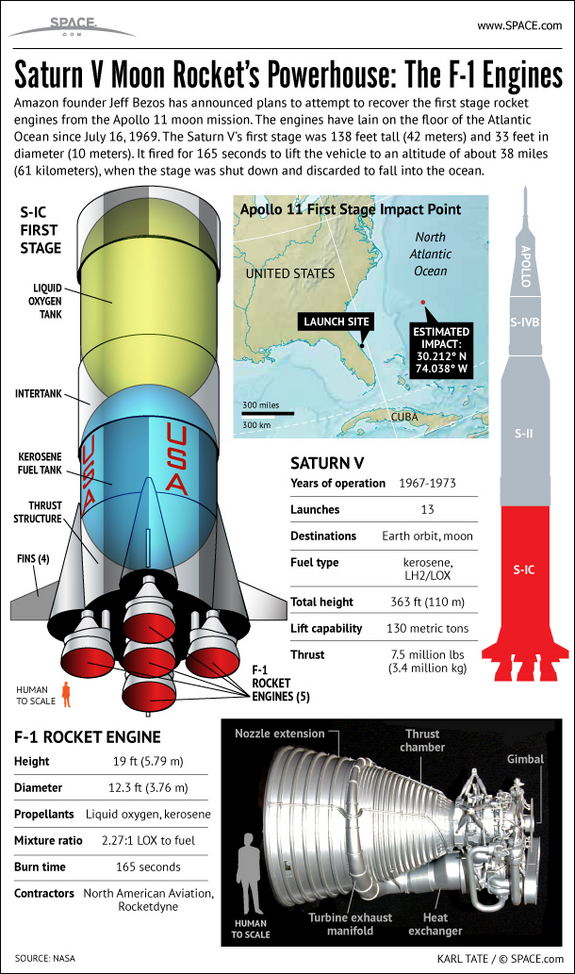Apollo F-1 Engines Recovery
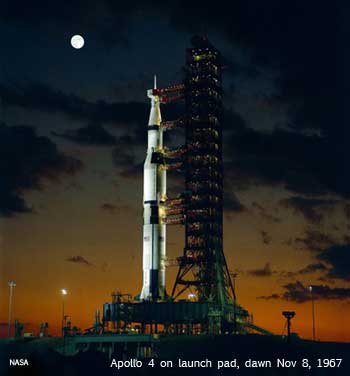
Man landed on the moon 44 years ago. The United States Apollo 11 landed on the moon July 20, 1969 with Neil Armstrong and Buzz Aldrin taking mans first walk in space almost 239,000 miles from earth. And the Soviets lost the race to be the 1st nation to walk on the moon.
The founder of Amazon.com, Jeff Bezos, watched as a child and never forgot that magical moment. Today, Mr. Bezos has the memory of mans first moon walk and the funding to lead an amazing exploration that ended yesterday with the recovery of F-1 engines believed to be from Apollo 11.
This exploration started to unfold on March 28, 2012, when Mr. Bezos's team announced the discovery of F-1 rocket engines using sonar equipment. And the plans began to extract his find located in 14,000 feet (2.65 miles) deep waters, 360 miles east of Cape Canaveral in the Atlantic Ocean.
On March 20, 2013, after 3 weeks of excavation using remotely operated vehicles, the team, working from the vessel Seabed Worker, extracted 2 rocket engines. Mr. Bezos has now secured his place in NASA history.
F-1 Engines travel 5000 mph for 3 minutes at 1.5M pounds thrust and a temp of 2500°F to go 38 miles!
NASA Administrator Congratulates Apollo Engine Recovery Team
David Weaver/Bob Jacobs Headquarters, Washington, News Release 13-082, March 20, 2013
WASHINGTON -- The following is a statement from NASA Administrator Charles Bolden on the successful recovery of Apollo Saturn V first stage engines announced Wednesday by Jeff Bezos, the founder and Chief Executive Officer of the aerospace company Blue Origin and Amazon.com.
"Nearly one year ago, Jeff Bezos shared with us his plans to recover F-1 engines that helped power Apollo astronauts to the moon in the late 1960s and early 1970s. We share the excitement expressed by Jeff and his team in announcing the recovery of two of the powerful Saturn V first-stage engines from the bottom of the Atlantic Ocean.
"This is a historic find and I congratulate the team for its determination and perseverance in the recovery of these important artifacts of our first efforts to send humans beyond Earth orbit.
"We look forward to the restoration of these engines by the Bezos team and applaud Jeff's desire to make these historic artifacts available for public display.
"Jeff and his colleagues at Blue Origin are helping to usher in a new commercial era of space exploration and we are confident our continued collaboration will soon result in private human access to space, creating jobs and driving America's leadership in innovation and exploration."
Submerged artifacts, especially those buried under the seabed, can remain preserved in remarkably good condition for centuries. The F-1 engines recovered by Bezos were in remarkable condition, probably due to the fact that they were made from heavy duty materials. The preservation of submerged artifacts is a delicate process that must be performed in controlled environments to stabilize the artifacts and prevent further corrosion after being exposed to its new oxygenated environment. As you can see in the images below, the engines recovered by the Bezos Expedition were in excellent condition.
F-1 engines of 13 Apollo rockets lie deep in the ocean waiting to be found. Like Florida's law on recovering historical artifacts, NASA retains ownership of any artifacts recovered from space missions, all of which eventually get displayed at a museum in a NASA facility or in the Smithsonian Institution. Those recovered yesterday are destine for an exhibit in the United States so we can all marvel their beauty.
F-1 Engines Recovered by Bezos Expeditions
"We've seen an underwater wonderland ? an incredible sculpture garden of twisted F-1 engines that tells the story of a fiery and violent end, one that serves testament to the Apollo program," Bezos said in a post on his Bezos Expeditions website.
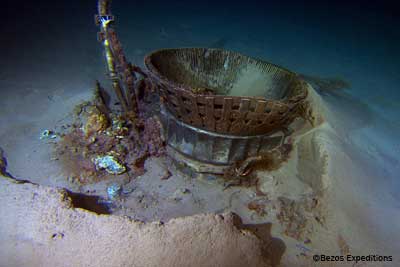
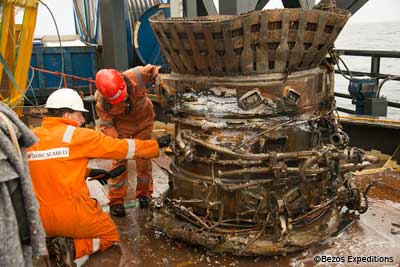
Read all about the mission at Bezos Expeditions.
F-1 Engines Powered the Saturn V Rockets
Sixty-five F-1 engines developed by Rocketdyne were used to launch 13 Saturn V rockets from 1967 to 1973. The 19 foot high by 12.3 foot diameter F-1 is a single-chamber liquid-fueled rocket engine with 1.5 million pounds of thrust that remains the most powerful ever developed to this date. The 5 engines, called five-engine cluster, were used on one rocket creating a whopping 7.5 million pounds of thrust! The F-1 engines burned at 2,500 degrees Fahrenheit for only 159 seconds (a little over 2 minutes) then detached from the main rocket and the F-1 engine falls back to earth, landing in the deep offshore waters of the middle Atlantic ocean. The Apollo's were launched from Cape Canaveral on Florida's east coast.
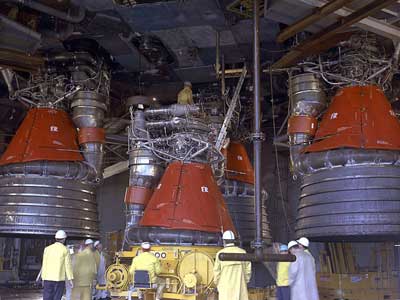
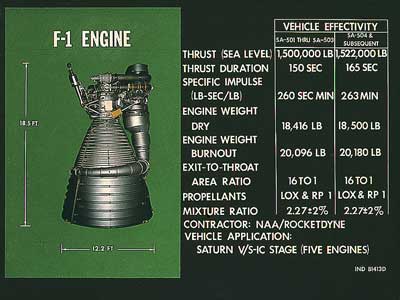
"We should not let our determination waver, and I do not believe that we shall. We have taken the first steps into space, and the world will never be the same again." -- Wernher Von Braun
On May 25, 1961, President John F. Kennedy delivered a speech to Congress in which he declared, "I believe that this nation should commit itself to achieving the goal, before this decade is out, of landing a man on the moon and returning him safely to Earth." On that same day, over 2,600 miles away at Edwards Air Force Base in California, the F-1 engine was being tested for the first time.
Developed by Rocketdyne for NASA under the direction of Marshall Space Flight Center, the 19 feet high and over 12 foot wide F-1 Liquid Propellant Rocket Engine (LPRE) remains the largest, most powerful single-nozzle, liquid fueled rocket ever made. The cluster of five engines powered the first stage of the Saturn V launch vehicle that was capable of placing 280,000 pounds of payload into low-Earth orbit. Each of the bell-shaped F-1 engines weighed over nine tons, generated 1.5 million pounds of thrust, and had a potential energy output equal to the power of eighty-five Hoover dams. Numerous test firings of the mammoth engine were conducted at Marshall Space Flight Center from 1963 to November of 1966 with a testing of the full complement of the five F-1s that made up the S-IC stage on April 16, 1965. Overall a total of ninety-eight engines were produced and sixty-five engines were flown on 13 Saturn V missions from 1967 to 1973.
Courtesy NASA/MSFC
Source: SPACE.com: All about our solar system, outer space and exploration
Where are the S1-C Stages?
The S1-C stages that hold the F-1 rocket engines are released after take off and fall back to earth and landing in the Atlantic Ocean. These huge first stage sections surprisingly have ever been recovered from any of the 13 Apollo missions. The recovery of the F-1 engine by the Bezos team is a history maker for sure. It is believed all the S1-C sections broke up when detached from the rocket as they hit the ocean, surely leaving behind a large debris field. Not a place for mariners to be when a rocket takes off. Back in the 1960's communications was not like it is today and we read about a German ship who was hit by a chunk of falling debris. The middle Atlantic is not explored for sunken treasure often due to its depth and distance, so a lot of artifacts go undiscovered.
Apollo 11
The Apollo 11 was the first rocket ship to land a man on the moon on July 16, 1969. This F-1 engines recovered by Bezos are hoped to be that from the Apollo 11. The recovered engines contain partial serial numbers on them and once confirmed, Bezos Expeditions will release the exact origin of the engine parts.
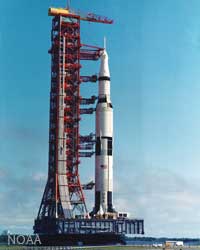
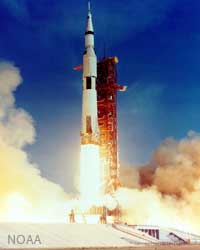
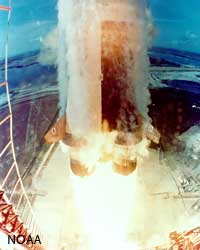
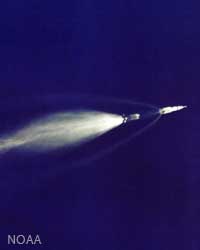
13 Apollo Flights Powered by the F-1 Engine

The F-1 Engine Today
The F-1 engine is still the most powerful single-chamber liquid-fueled rocket engine to this day. Today, engineers are working a a new powerful, cost effective propulsion system to launch future space exploration. The engineers of NASA's Marshall Space Flight Center in Huntsville, Alabama are currently building and testing a new F-1 engine based on original drawings and parts. For more information NASA Engineers Resurrect And Test Mighty F-1 Engine Gas Generator.
For more information visit:
- Bezos Expeditions
- Collection of Images on Flickr
- NASA Apollo Missions
- NASA F-1 Engine Fact Sheet
- The Apollo Program on Wikipedia
Liz Lombardi, March 21, 2013
This information is provided only as a courtesy and there are NO guaranties, warranties, express or implied, or representations as to the accuracy of this content. Florida Go Fishing assumes NO liability or responsibility for any errors or omissions in the information contained here. If you find an error or omission in the data, please feel free to contact us with the correct information and we will verify the error or omission and correct it as soon as possible.



